sensor TOYOTA SEQUOIA 2019 (in English) Owner's Guide
[x] Cancel search | Manufacturer: TOYOTA, Model Year: 2019, Model line: SEQUOIA, Model: TOYOTA SEQUOIA 2019Pages: 560, PDF Size: 10.83 MB
Page 268 of 560
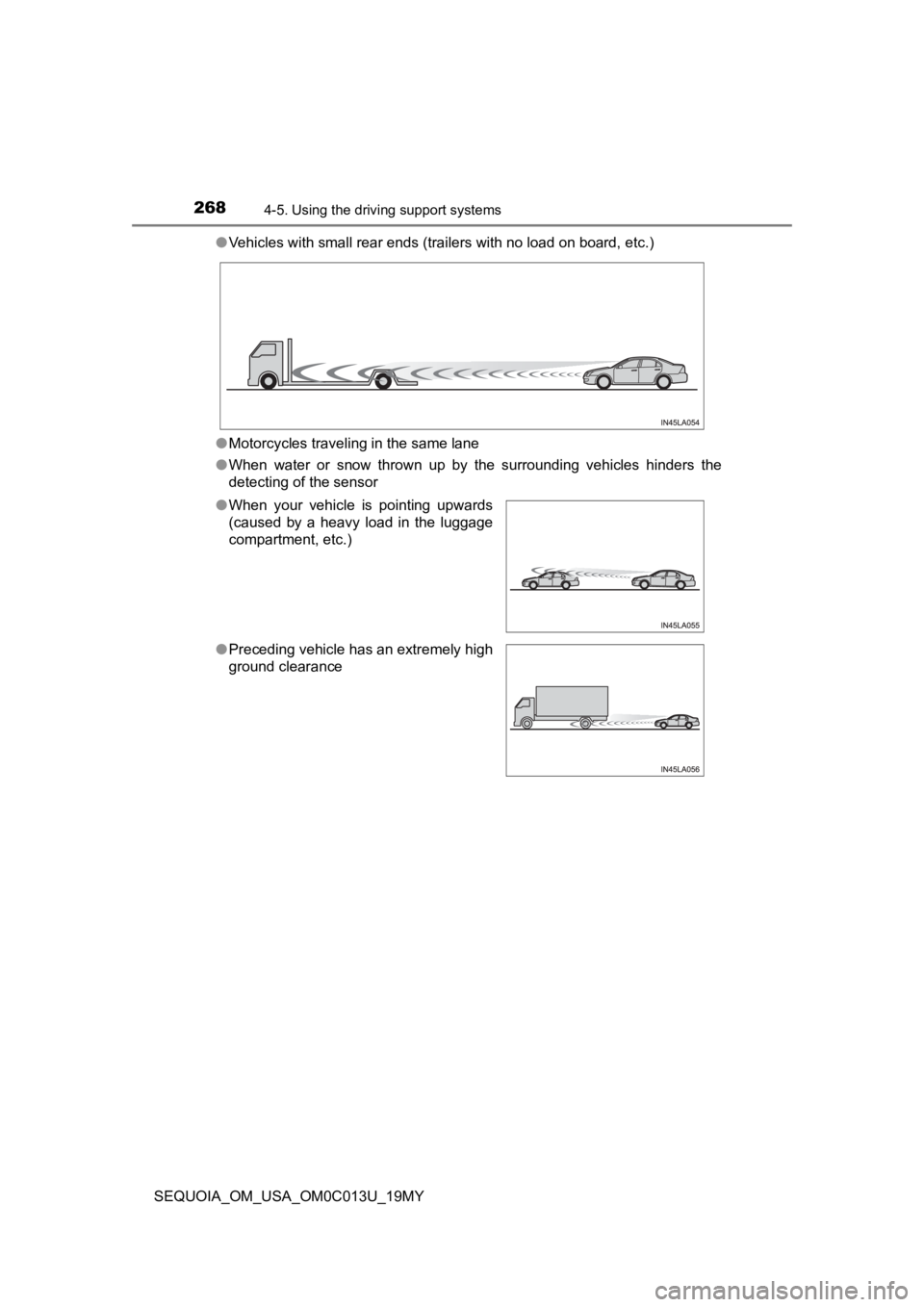
2684-5. Using the driving support systems
SEQUOIA_OM_USA_OM0C013U_19MY●
Vehicles with small rear ends (trailers with no load on board, etc.)
● Motorcycles traveling in the same lane
● When water or snow thrown up by the surrounding vehicles hinders the
detecting of the sensor
●When your vehicle is pointing upwards
(caused by a heavy load in the luggage
compartment, etc.)
● Preceding vehicle has an extremely high
ground clearance
Page 269 of 560
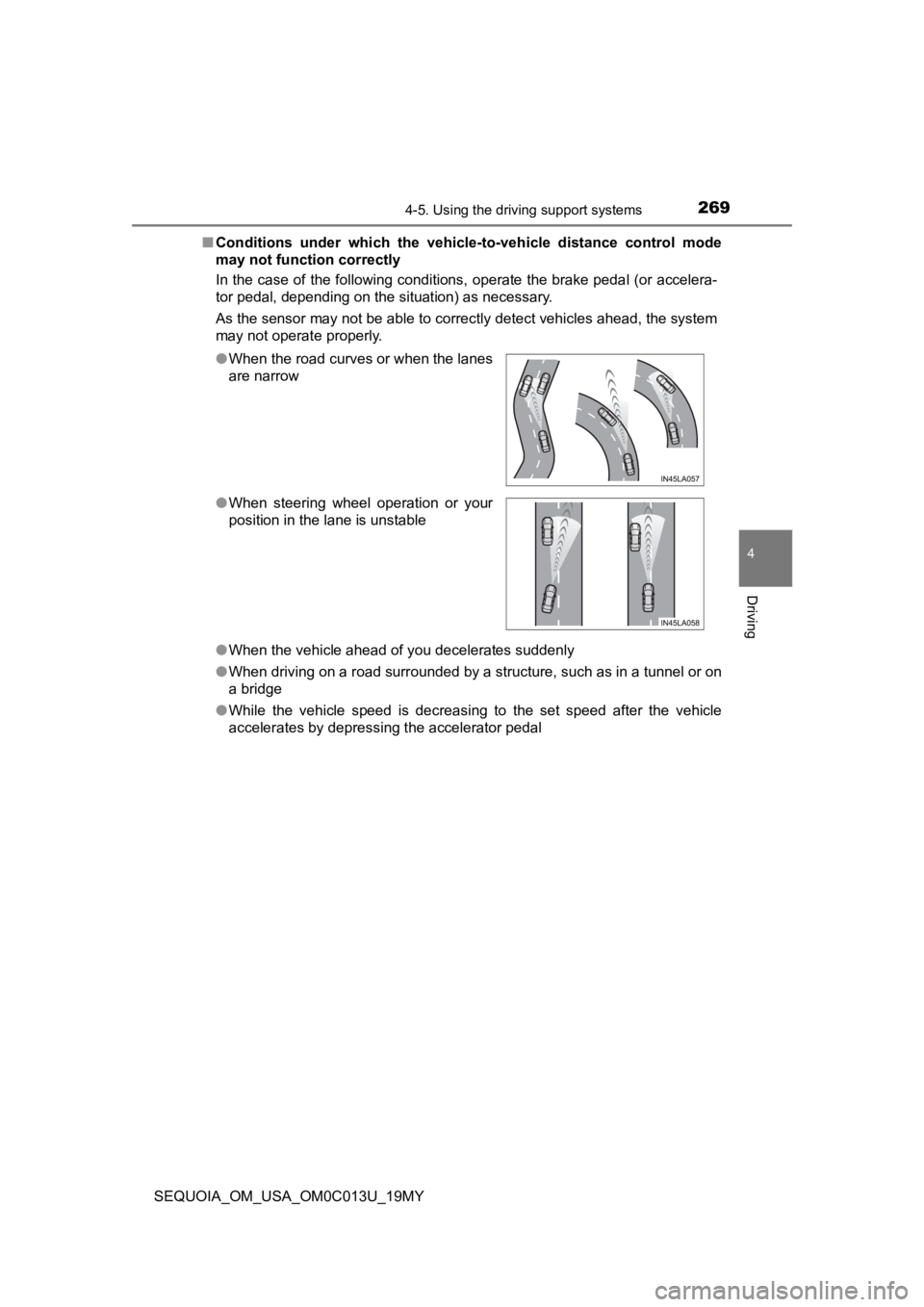
2694-5. Using the driving support systems
4
Driving
SEQUOIA_OM_USA_OM0C013U_19MY■
Conditions under which the vehic le-to-vehicle distance control mode
may not function correctly
In the case of the following conditions, operate the brake peda l (or accelera-
tor pedal, depending on the situation) as necessary.
As the sensor may not be able to correctly detect vehicles ahead, the system
may not operate properly.
● When the vehicle ahead of you decelerates suddenly
● When driving on a road surrounded by a structure, such as in a tunnel or on
a bridge
● While the vehicle speed is decreasing to the set speed after th e vehicle
accelerates by depressing the accelerator pedal
●
When the road curves or when the lanes
are narrow
● When steering wheel operation or your
position in the lane is unstable
Page 270 of 560
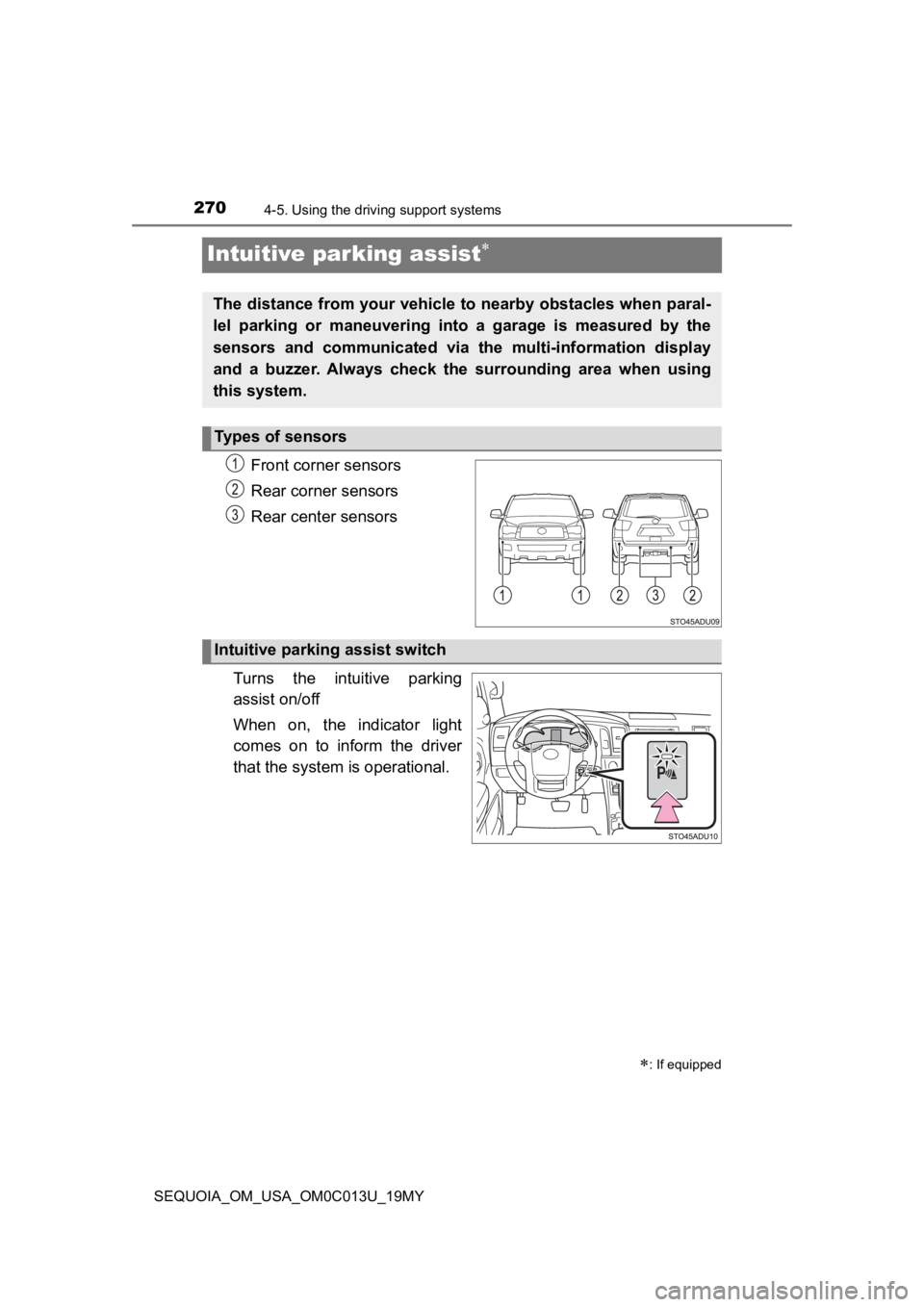
2704-5. Using the driving support systems
SEQUOIA_OM_USA_OM0C013U_19MY
Intuitive parking assist
Front corner sensors
Rear corner sensors
Rear center sensors
Turns the intuitive parking
assist on/off
When on, the indicator light
comes on to inform the driver
that the system is operational.
: If equipped
The distance from your vehicle to nearby obstacles when paral-
lel parking or maneuvering into a garage is measured by the
sensors and communicated via t he multi-information display
and a buzzer. Always check the surrounding area when using
this system.
Types of sensors
Intuitive parking assist switch
Page 271 of 560
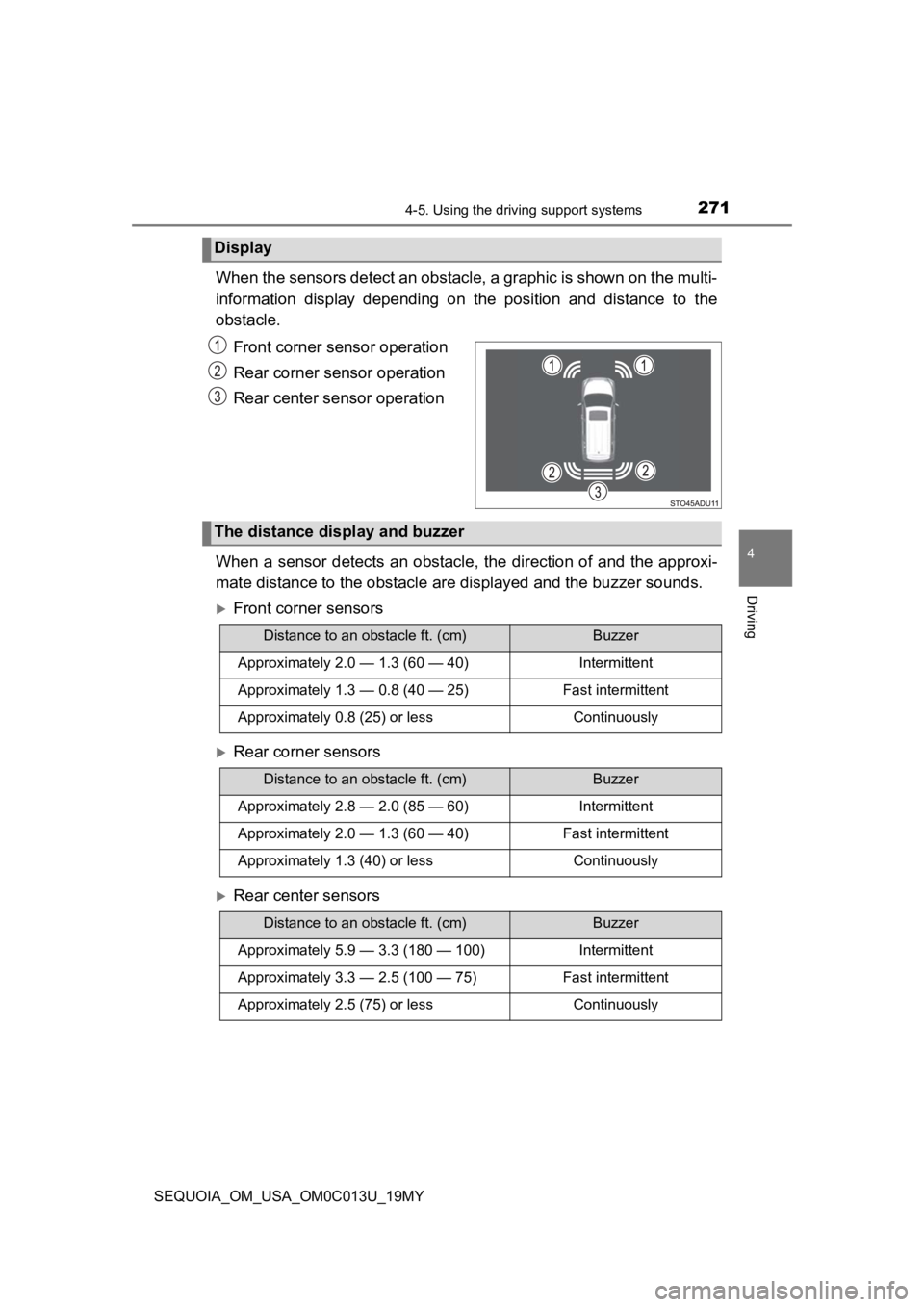
2714-5. Using the driving support systems
4
Driving
SEQUOIA_OM_USA_OM0C013U_19MY
When the sensors detect an obstacle, a graphic is shown on the multi-
information display depending on the position and distance to t he
obstacle.
Front corner sensor operation
Rear corner sensor operation
Rear center sensor operation
When a sensor detects an obstacl e, the direction of and the approxi-
mate distance to the obstacle ar e displayed and the buzzer soun ds.
Front corner sensors
Rear corner sensors
Rear center sensors
Display
The distance display and buzzer
Distance to an obstacle ft. (cm)Buzzer
Approximately 2.0 — 1.3 (60 — 40)Intermittent
Approximately 1.3 — 0.8 (40 — 25)Fast intermittent
Approximately 0.8 (25) or lessContinuously
Distance to an obstacle ft. (cm)Buzzer
Approximately 2.8 — 2.0 (85 — 60)Intermittent
Approximately 2.0 — 1.3 (60 — 40)Fast intermittent
Approximately 1.3 (40) or lessContinuously
Distance to an obstacle ft. (cm)Buzzer
Approximately 5.9 — 3.3 (180 — 100)Intermittent
Approximately 3.3 — 2.5 (100 — 75)Fast intermittent
Approximately 2.5 (75) or lessContinuously
Page 272 of 560
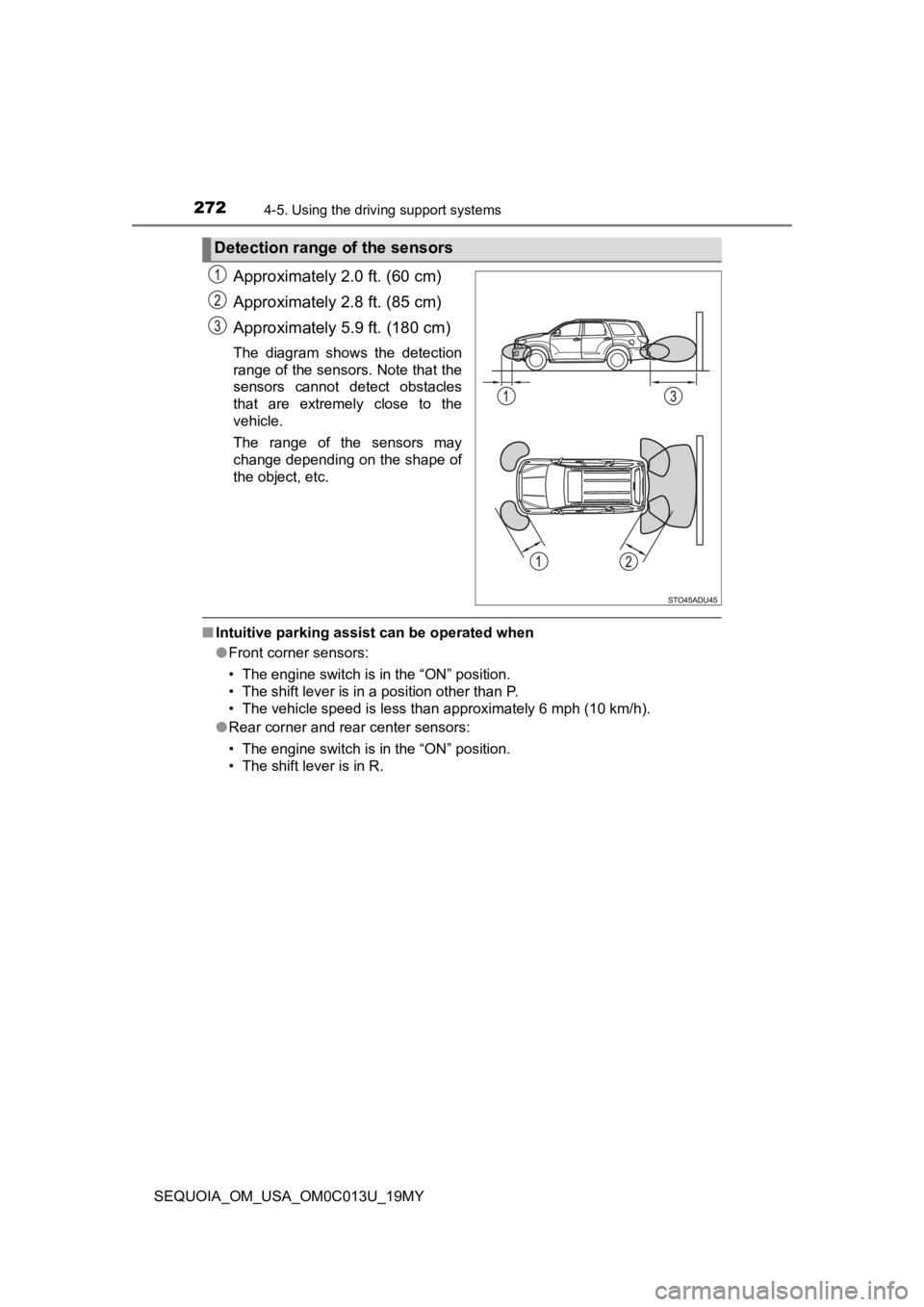
2724-5. Using the driving support systems
SEQUOIA_OM_USA_OM0C013U_19MY
Approximately 2.0 ft. (60 cm)
Approximately 2.8 ft. (85 cm)
Approximately 5.9 ft. (180 cm)
The diagram shows the detection
range of the sensors. Note that the
sensors cannot detect obstacles
that are extremely close to the
vehicle.
The range of the sensors may
change depending on the shape of
the object, etc.
■Intuitive parking assist can be operated when
●Front corner sensors:
• The engine switch is in the “ON” position.
• The shift lever is in a position other than P.
• The vehicle speed is less than approximately 6 mph (10 km/h).
● Rear corner and rear center sensors:
• The engine switch is in the “ON” position.
• The shift lever is in R.
Detection range of the sensors
Page 273 of 560
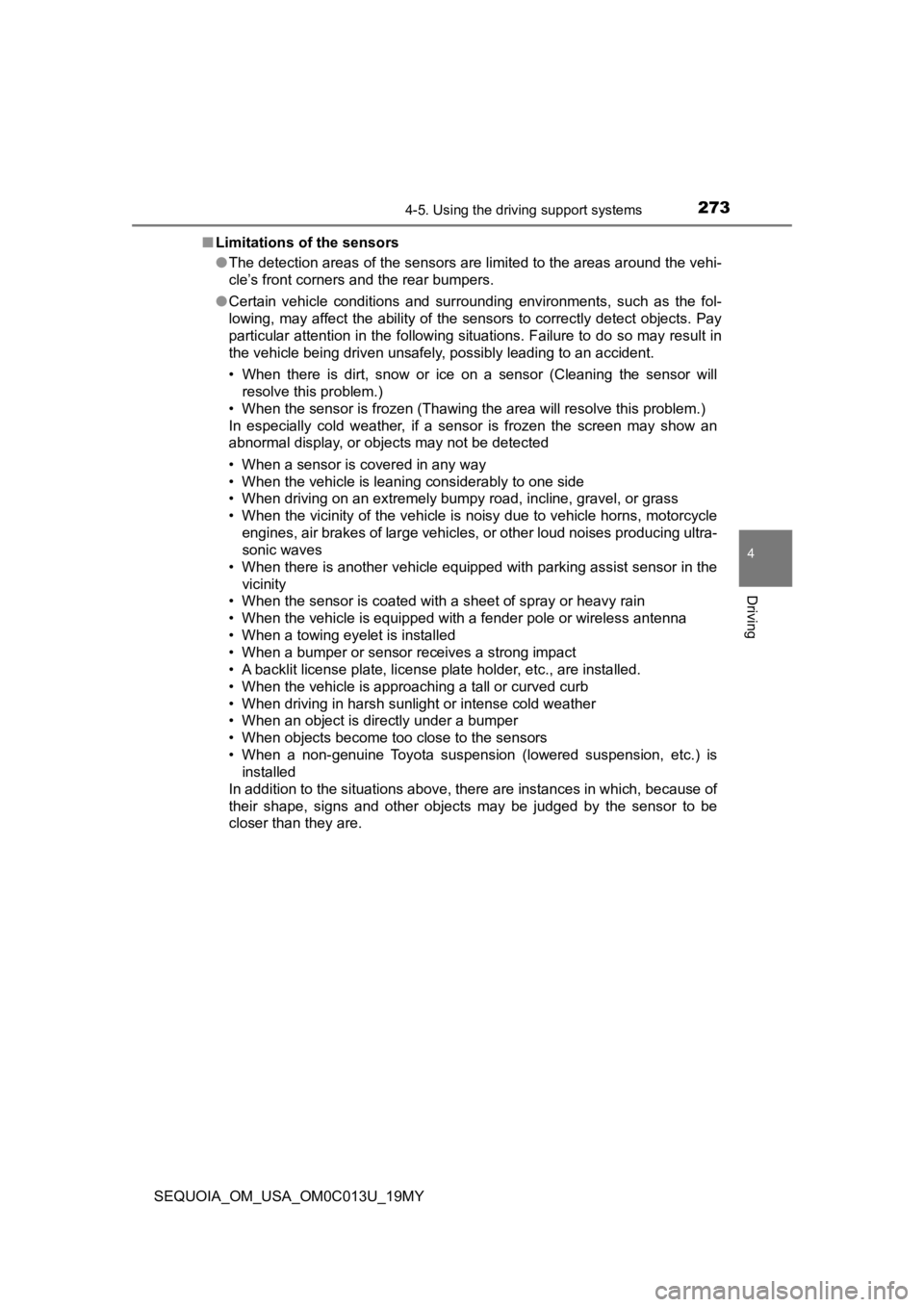
2734-5. Using the driving support systems
4
Driving
SEQUOIA_OM_USA_OM0C013U_19MY■
Limitations of the sensors
●The detection areas of the sensors are limited to the areas aro und the vehi-
cle’s front corners and the rear bumpers.
● Certain vehicle conditions and surrounding environments, such a s the fol-
lowing, may affect the ability of the sensors to correctly dete ct objects. Pay
particular attention in the following situations. Failure to do so may result in
the vehicle being driven unsafely, possibly leading to an accident.
• When there is dirt, snow or ice on a sensor (Cleaning the sens or will
resolve this problem.)
• When the sensor is frozen (Thawing the area will resolve this problem.)
In especially cold weather, if a sensor is frozen the screen ma y show an
abnormal display, or objects may not be detected
• When a sensor is covered in any way
• When the vehicle is leaning considerably to one side
• When driving on an extremely bumpy road, incline, gravel, or g rass
• When the vicinity of the vehicle is noisy due to vehicle horns , motorcycle
engines, air brakes of large vehicles, or other loud noises pro ducing ultra-
sonic waves
• When there is another vehicle equipped with parking assist sen sor in the
vicinity
• When the sensor is coated with a sheet of spray or heavy rain
• When the vehicle is equipped with a fender pole or wireless an tenna
• When a towing eyelet is installed
• When a bumper or sensor receives a strong impact
• A backlit license plate, license plate holder, etc., are insta lled.
• When the vehicle is approaching a tall or curved curb
• When driving in harsh sunlight or intense cold weather
• When an object is directly under a bumper
• When objects become too close to the sensors
• When a non-genuine Toyota suspension (lowered suspension, etc. ) is
installed
In addition to the situations above, there are instances in which, because of
their shape, signs and other objects may be judged by the senso r to be
closer than they are.
Page 274 of 560
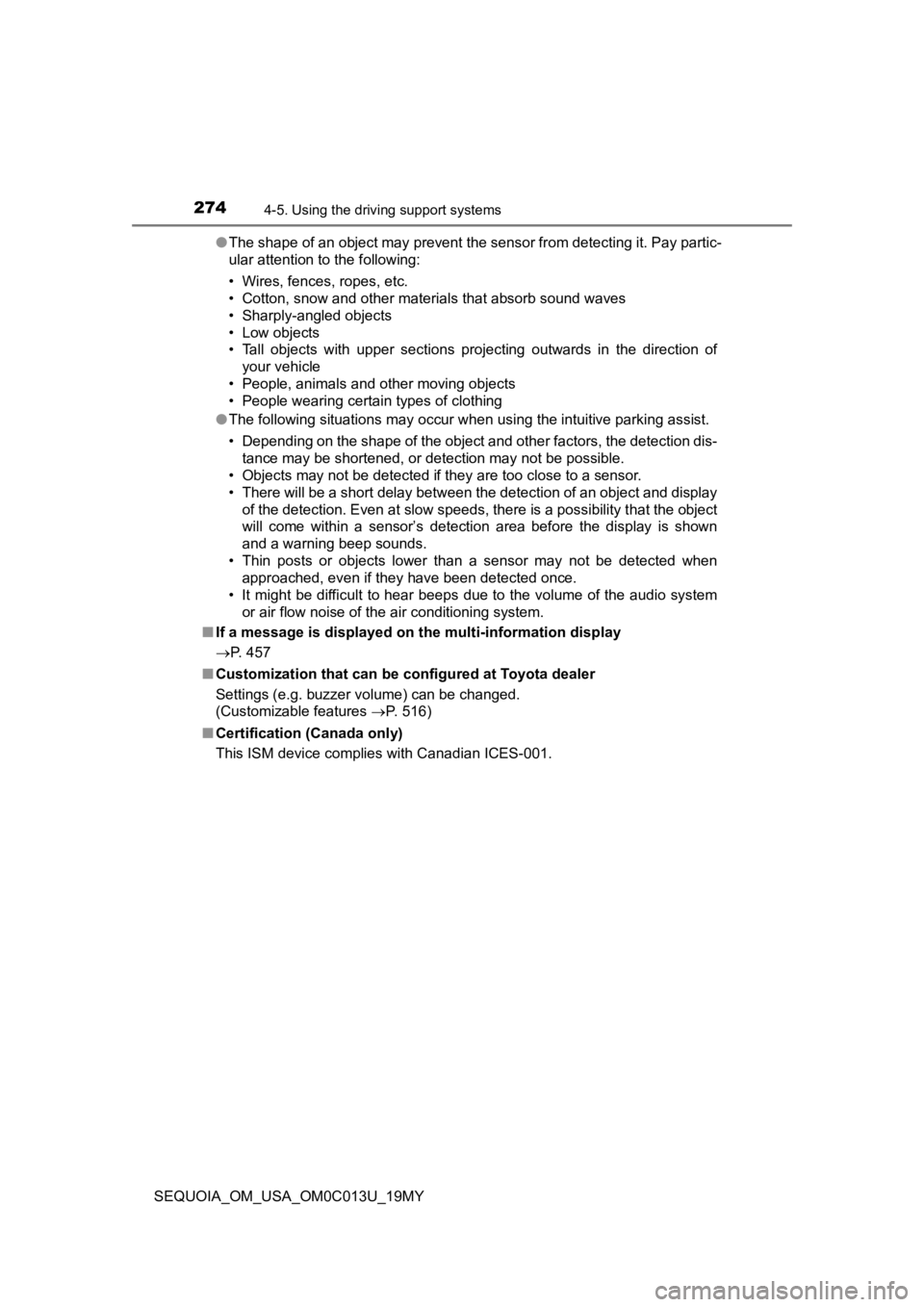
2744-5. Using the driving support systems
SEQUOIA_OM_USA_OM0C013U_19MY●
The shape of an object may prevent the sensor from detecting it. Pay partic-
ular attention to the following:
• Wires, fences, ropes, etc.
• Cotton, snow and other materials that absorb sound waves
• Sharply-angled objects
• Low objects
• Tall objects with upper sections projecting outwards in the direction of
your vehicle
• People, animals and other moving objects
• People wearing certain types of clothing
● The following situations may occur when using the intuitive parking assist.
• Depending on the shape of the object and other factors, the de tection dis-
tance may be shortened, or detection may not be possible.
• Objects may not be detected if they are too close to a sensor.
• There will be a short delay between the detection of an object and display
of the detection. Even at slow speeds, there is a possibility t hat the object
will come within a sensor’s detection area before the display i s shown
and a warning beep sounds.
• Thin posts or objects lower than a sensor may not be detected when
approached, even if they have been detected once.
• It might be difficult to hear beeps due to the volume of the a udio system
or air flow noise of the air conditioning system.
■ If a message is displayed on th e multi-information display
P. 457
■ Customization that can be configured at Toyota dealer
Settings (e.g. buzzer volume) can be changed.
(Customizable features P. 516)
■ Certification (Canada only)
This ISM device complies with Canadian ICES-001.
Page 275 of 560
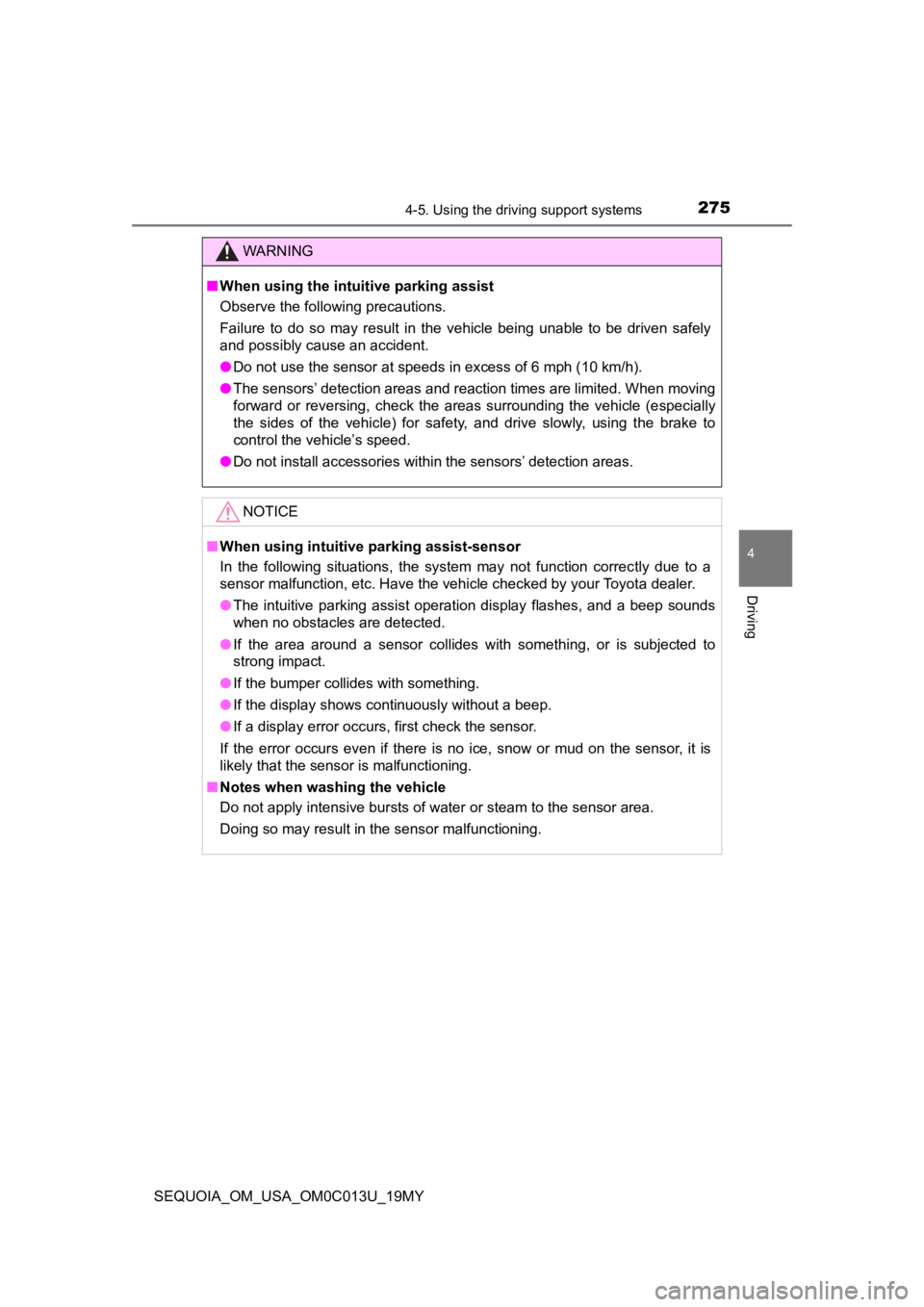
2754-5. Using the driving support systems
4
Driving
SEQUOIA_OM_USA_OM0C013U_19MY
WARNING
■When using the intuitive parking assist
Observe the following precautions.
Failure to do so may result in the vehicle being unable to be d riven safely
and possibly cause an accident.
● Do not use the sensor at speeds in excess of 6 mph (10 km/h).
● The sensors’ detection areas and reaction times are limited. When moving
forward or reversing, check the areas surrounding the vehicle ( especially
the sides of the vehicle) for safety, and drive slowly, using t he brake to
control the vehicle’s speed.
● Do not install accessories within the sensors’ detection areas.
NOTICE
■When using intuitive parking assist-sensor
In the following situations, the system may not function correctly due to a
sensor malfunction, etc. Have the vehicle checked by your Toyota dealer.
● The intuitive parking assist operation display flashes, and a beep sounds
when no obstacles are detected.
● If the area around a sensor collides with something, or is subjected to
strong impact.
● If the bumper collides with something.
● If the display shows continuously without a beep.
● If a display error occurs, first check the sensor.
If the error occurs even if there is no ice, snow or mud on the sensor, it is
likely that the sensor is malfunctioning.
■ Notes when washing the vehicle
Do not apply intensive bursts of water or steam to the sensor a rea.
Doing so may result in the sensor malfunctioning.
Page 276 of 560
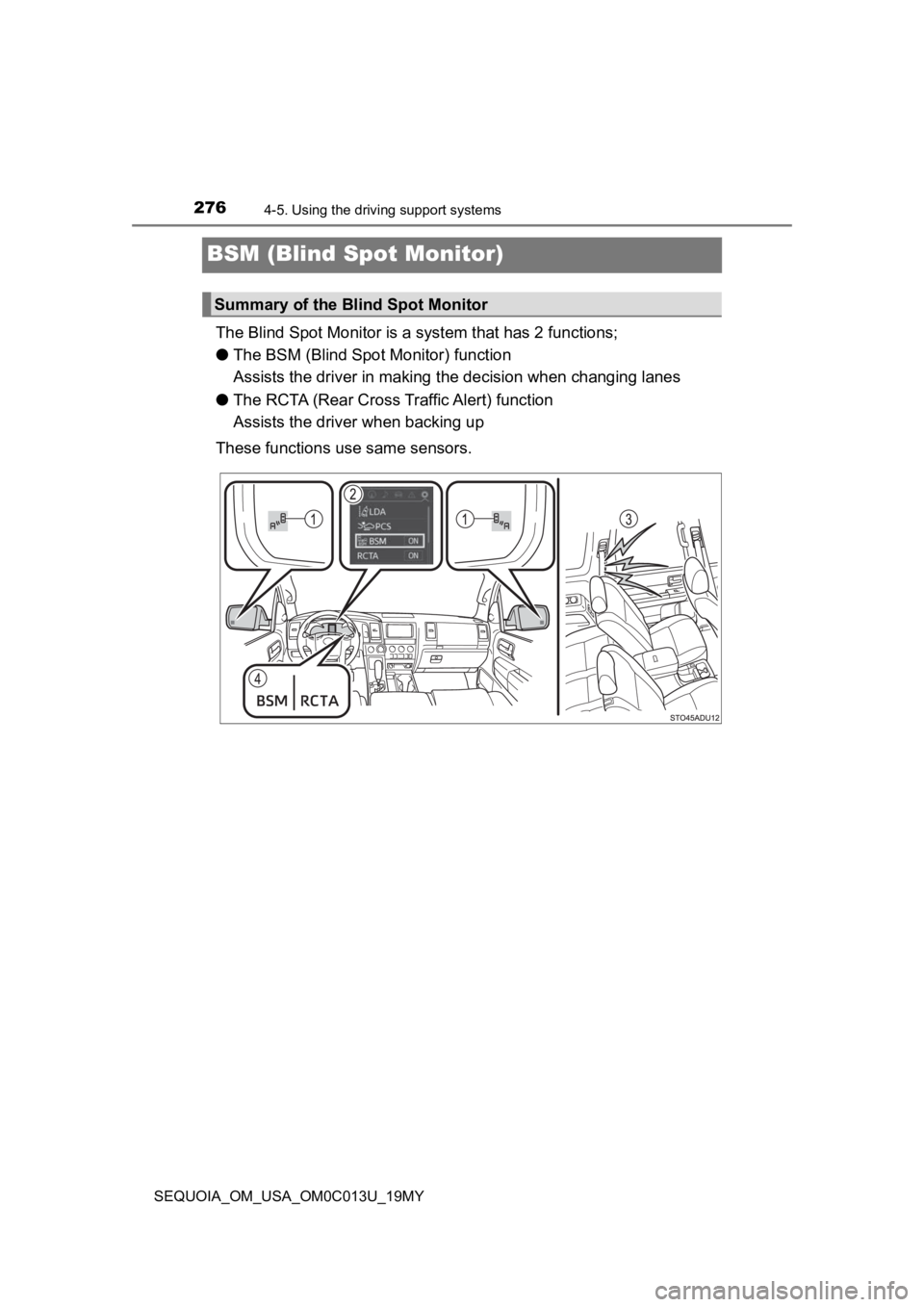
2764-5. Using the driving support systems
SEQUOIA_OM_USA_OM0C013U_19MY
BSM (Blind Spot Monitor)
The Blind Spot Monitor is a system that has 2 functions;
● The BSM (Blind Spot Monitor) function
Assists the driver in making t he decision when changing lanes
● The RCTA (Rear Cross Tra ffic Alert) function
Assists the driver when backing up
These functions use same sensors.
Summary of the Blind Spot Monitor
Page 278 of 560

2784-5. Using the driving support systems
SEQUOIA_OM_USA_OM0C013U_19MY
Press “” or “” of the meter control switches, select .
Press “ ” or “ ” of the meter control switches, select “BSM” or
“RCTA”, and then press .
The function switches On/Off with each press.
Press “<” or “>” of the meter control switches, select .
Press “ ” or “ ” of the meter control switches, select “BSM Bright-
ness”, and then press .
The brightness changes with each press.
Press “<” or “>” of the meter control switches, select .
Press “ ” or “ ” of the meter control switches, select “RCTA Vol-
ume”, and then press .
The warning buzzer volume changes with each press.
■ The outside rear view mirror indicators visibility
When under strong sunlight, the outside rear view mirror indica tor may be dif-
ficult to see.
■ Hearing the RCTA buzzer
The RCTA buzzer may be difficult to hear over loud noises, such as if the
audio system volume is high.
■ When there is a malfunction in t he Blind Spot Monitor/Rear Cros s Traffic
Alert system
If a system malfunction is detected due to any of the following reasons, warn-
ing messages will be displayed: ( P. 459)
● There is a malfunction with the sensors
● The sensors have become dirty
● The outside temperature is extremely high or low
● The sensor voltage has become abnormal
Turning the BSM function/RCTA function on/off
Changing the BSM indicator brightness
Changing the Rear Cross Traffic Alert warning buzzer volume
1
2
1
2
1
2